Building high-performing landing pages is a priority for many marketers — and for good reason. If you read our article about the importance of great landing pages, then you know just how important they are for boosting conversion rates, driving leads and closing sales. In that article, we also introduced you to some of the best tools that can help you get started with building and optimizing your landing pages.
In this article, we’re taking a deeper look at four popular landing page builders — HubSpot, Unbounce, Instapage and Optimizely — to weigh the advantages and disadvantages of each to help you determine which tool is best for you and your business.
How we review each landing page builder:
To ensure we conduct fair reviews of each tool, we use the following criteria:
- Time to get going. Building landing pages can be incredibly time-consuming and frustrating if you aren’t tech-savvy or an experienced designer. How easy is it to set up and use this tool?
- Ease of use. How is the user interface designed? How easy is it to use overall?
- Feature richness. What features are available? Are the features helpful? Do the features provide value for the cost?
- Price. How much does the platform cost? What is the overall cost versus value?
At the end of this article, I will provide an overall grade, show a grading rubric summary and declare a “best in building landing pages winner.”
Deep-dive review: HubSpot
If you’ve seen some of my other articles, you know that I’m a huge fan of marketing automation solutions in general, and Hubspot in particular. I’ve covered topics such as Hubspot email marketing power-user secrets, how to setup Hubspot/Zapier powered sales alerts in Slack and leveraging Hubspot to grow your online audience. I’ve neglected to discuss how awesome Hubspot can be for creating landing pages, however, and aim to rectify that error here.
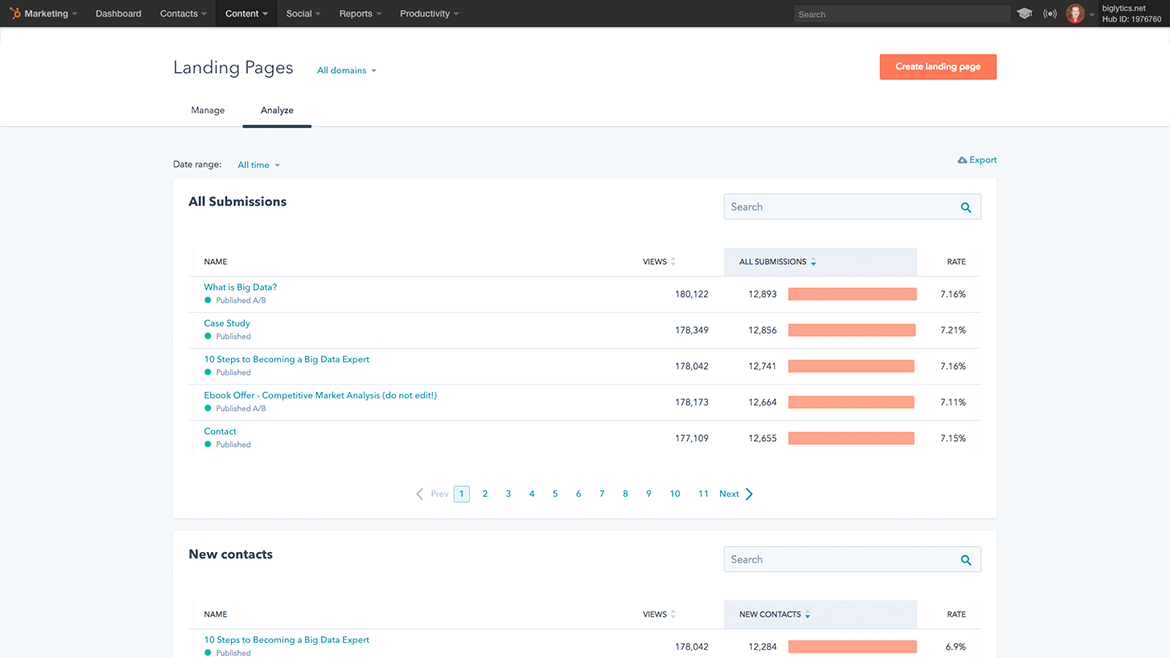
HubSpot pros:
Feature richness. Because HubSpot is an all-in-one, full marketing suite platform, the features are truly endless. HubSpot provides the necessary features and functionalities that should be in every marketer’s toolbox, including data analytics and reporting, social media, email marketing, lead flows, landing pages and more.
Of course, while I’m a big fan of all of the HubSpot features, its landing page building is exceptionally feature-rich: dozens of mobile-friendly landing page templates, multi-device previewing, personalized content, personalized CTAs and A/B testing. For your cross-funnel marketing needs (i.e. tieing inbound marketing efforts to dynamic content on the landing page) HubSpot comes across as the most feature-rich landing page builder of the four reviewed here.
Time to get going. HubSpot is relatively easy to set up and use. At one point, setting up HubSpot may have required a technical person to connect the back end of the platform to a website, however, this process has been streamlined for greater ease and efficiency.
HubSpot also offers a number of online courses, videos and training resources to help its users become experts.
Ease of use. Once set up and enabled, users can create, build and publish landing pages in a matter of minutes. You don’t need to have any HTML/CSS or other coding knowledge, as the point and click builder makes launching new pages extremely quick and easy. HubSpot also makes it easy to edit and make changes to landing pages after they are live.
HubSpot cons:
Price. One of the biggest complaints from HubSpot users is the cost. Although the marketing dashboard starts at only $50 per month, most users need more functionality and only see benefits from subscribing to both the Marketing and Sales hub platforms.
For a complete subscription to both the Marketing and Sales platforms, this can cost businesses upwards of $800 per month. This is often way above budget for many marketers and businesses. However, the businesses that do pay the high cost claim it is well worth it.
Grade: A (4.25 out of 5 possible points)
Deep-dive review: Unbounce
Unlike HubSpot, which does a lot for marketers up and down the customer journey, Unbounce focuses on building landing pages that improve conversion rates. It does that very well, too, as you’ll see in the PROS section below.
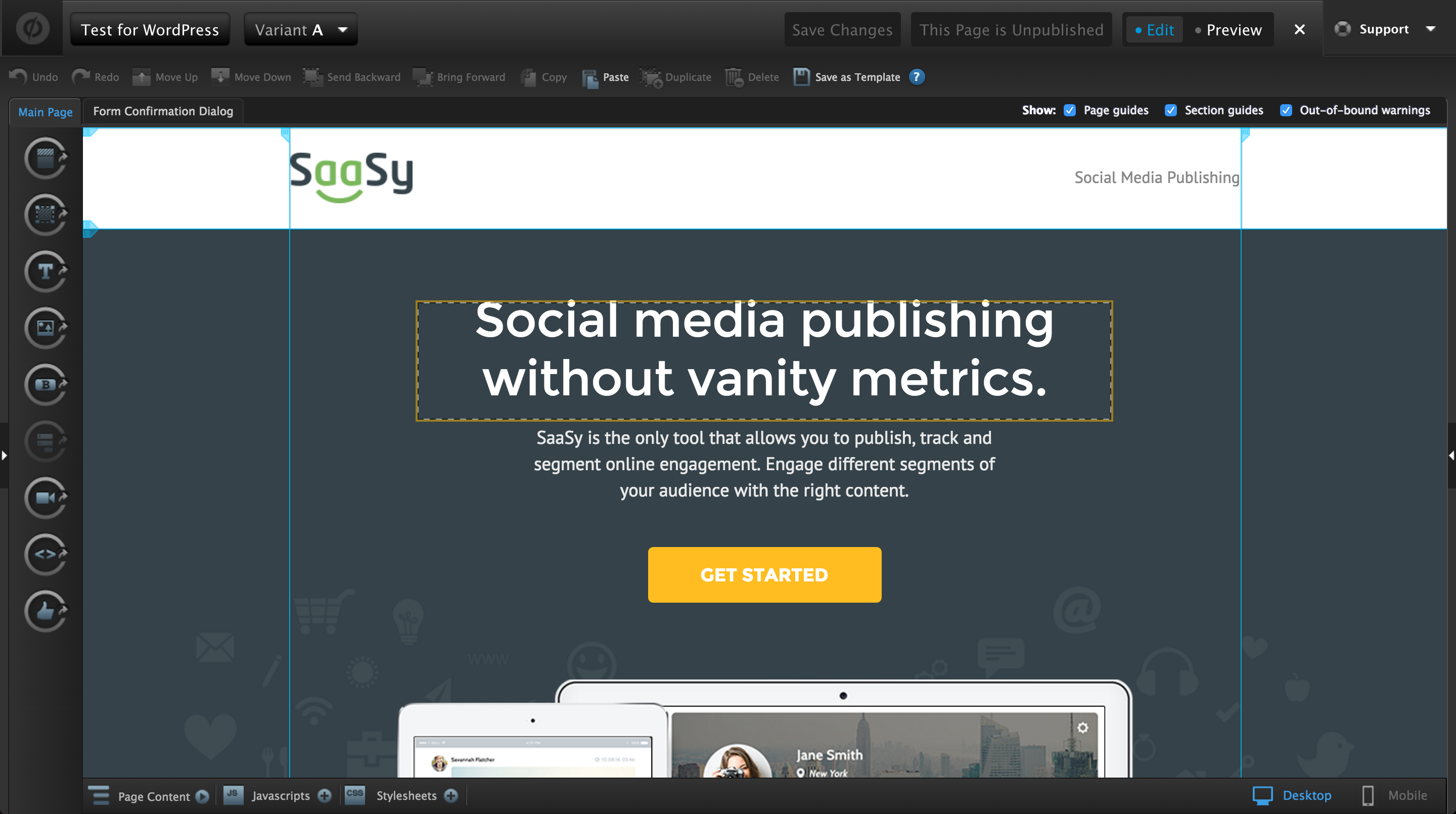
Unbounce pros:
Time to get going. Unbounce is another popular landing page builder solution that makes creating and building landing pages a snap. After setting up an account, users can browse the library of landing page templates, select a template to work with and begin customizing it to make it their own. One aspect of Unbounce that sets it above the other landing page builders, in regards to template offerings, is that its landing page template library has industry-specific templates that are directly aimed at increasing conversion rates. Select your industry, and then the template, and you’re off to the races in less time and hassle then you might have with a different builder.
Feature richness. Although Unbounce is a dedicated landing page builder with an easy-to-use drag-and-drop feature, it also offers other features and functionalities for users, which include a complete library of landing page templates as well as an option to create pixels and codes to share on websites. For those who love good design, font selection is imperative, and in this regard, Unbounce won’t let you down; with over 840 fonts, Unbounce built landing pages allow you to go beyond the boring websafe fonts of the past.
Price. Unbounce monthly plans start at $79 per month. There is also an annual billing option available at a discount. Although this is technically higher than HubSpot, Unbounce might end up being a more cost-effective option than multiple HubSpot platforms.
Unbounce also offers a free trial as well as a chance to preview the builder, which provides users with a great way to “test” the tool before paying for it.
Unbounce cons:
Ease of use. Although Unbounce is designed with their self-proclaimed “easy drag-and-drop builder,” users claim that it isn’t as easy to use. In my own experience, and in shared experiences from peers, you should expect learning Unbounce to take at least 30 minutes to figure out how the tool works and get a strong grasp of the functionality, which is time that many marketers and entrepreneurs simply don’t have.
Grade: A- (3.9 out of 5 possible points)
Deep-dive review: Instapage
Instapage and Unbounce share a lot of the same corporate goals: help marketers build great landing pages that perform the task of getting site visitors to give you their information or buy your product. While Instapage is very similar to Unbounce in mission and functionality, its pricing and lack of phone support make it less of a competitor to the other solutions reviewed here.
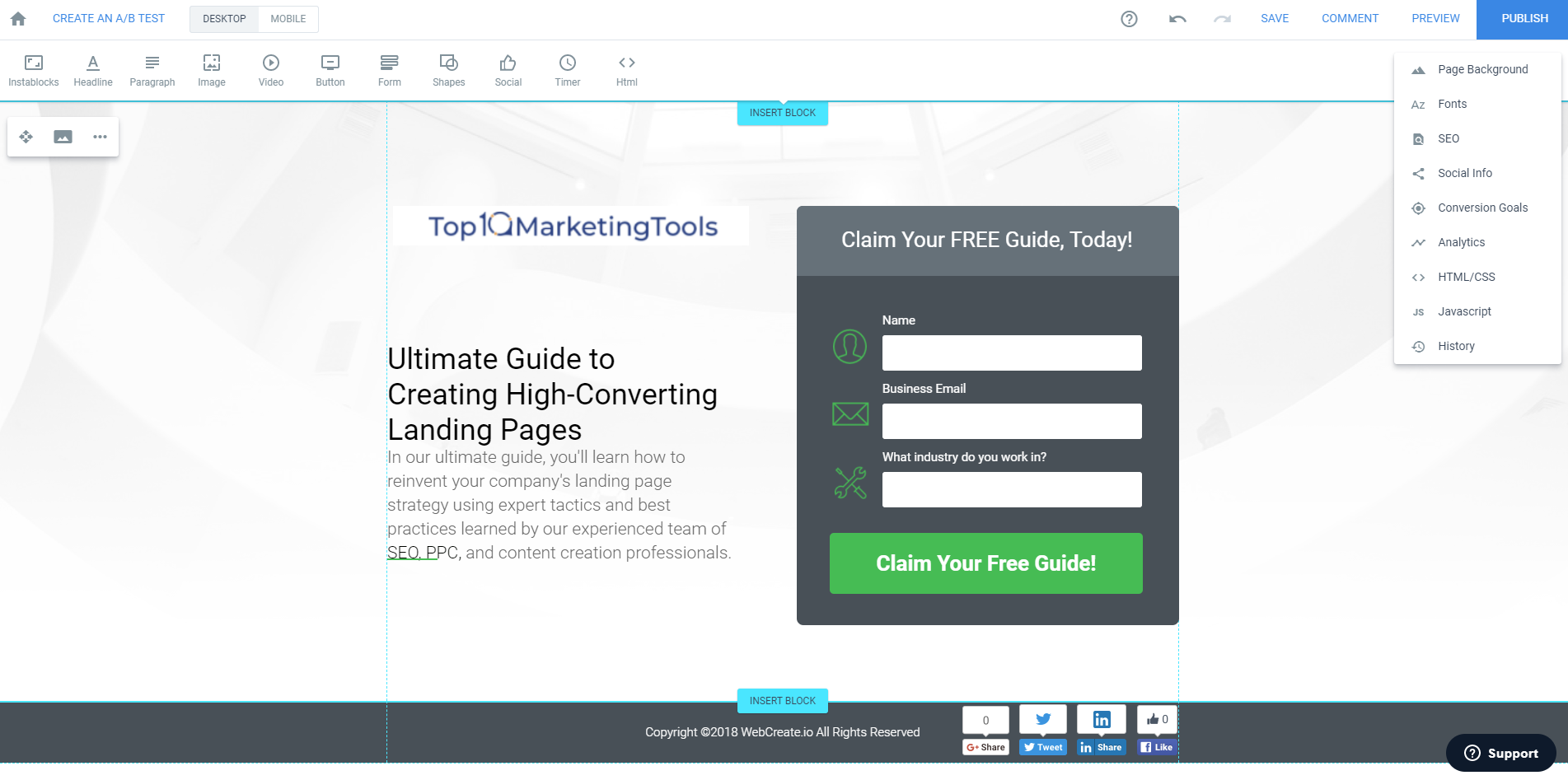
Instapage pros:
Time to get going. Instapage is an incredibly popular landing page builder. Many marketers use this great tool to build high-performing, highly-attractive landing pages in a matter of minutes. Instapage is also super easy to set up and use. We can attribute this to its clean, organized, and modern user interface, enjoyed by many of its loyal users.
Feature richness. Instapage is designed with InstaBlocks, which is the tool’s proprietary drag-and-drop “content block” feature, allowing users to add any elements they want to include on their landing pages, including CTAs, forms, visuals, testimonials and so on.
Instapage also offers A/B test features, allowing users to better understand audience behavior, tweak their design and/or copy and boost conversion rates. Users can also push Instapage conversion data to Google Analytics as well as Google Ads to track conversions and ad spend for businesses with a paid marketing strategy.
Ease of use. After reading a handful of customer reviews, Instapage is very easy to use. In fact, many users claim Instapage is a “lifesaver” when it comes to building beautiful landing pages that boost conversions in a matter of minutes.
Instapage cons:
Price. Although Instapage has a number of advantages, the biggest disadvantage is cost. Instapage and its many features can cost users $99 per month, which is the most expensive option we’ve reviewed thus far. Considering the features and functionality offered by Instapage compared to those by Unbounce and HubSpot, Instapage definitely seems to be priced on the high side.
Grade: B+ (3.7 out of 5 possible points)
Deep-dive review: Optimizely
If you’re a big optimizer, Optimizely is the solution for you. As a leader in on-site optimization software, it’s tool allows you to A/B test to your heart’s desire. It allows for multi-page experimentation, multivariate evaluation and personalized campaigns. However, as I think any Optimizely user would agree, it isn’t as much a landing page builder as it is an online optimization tool. I’ve included it in this list, though, as it provides a great source of landing page optimization for someone who already has a landing page builder.
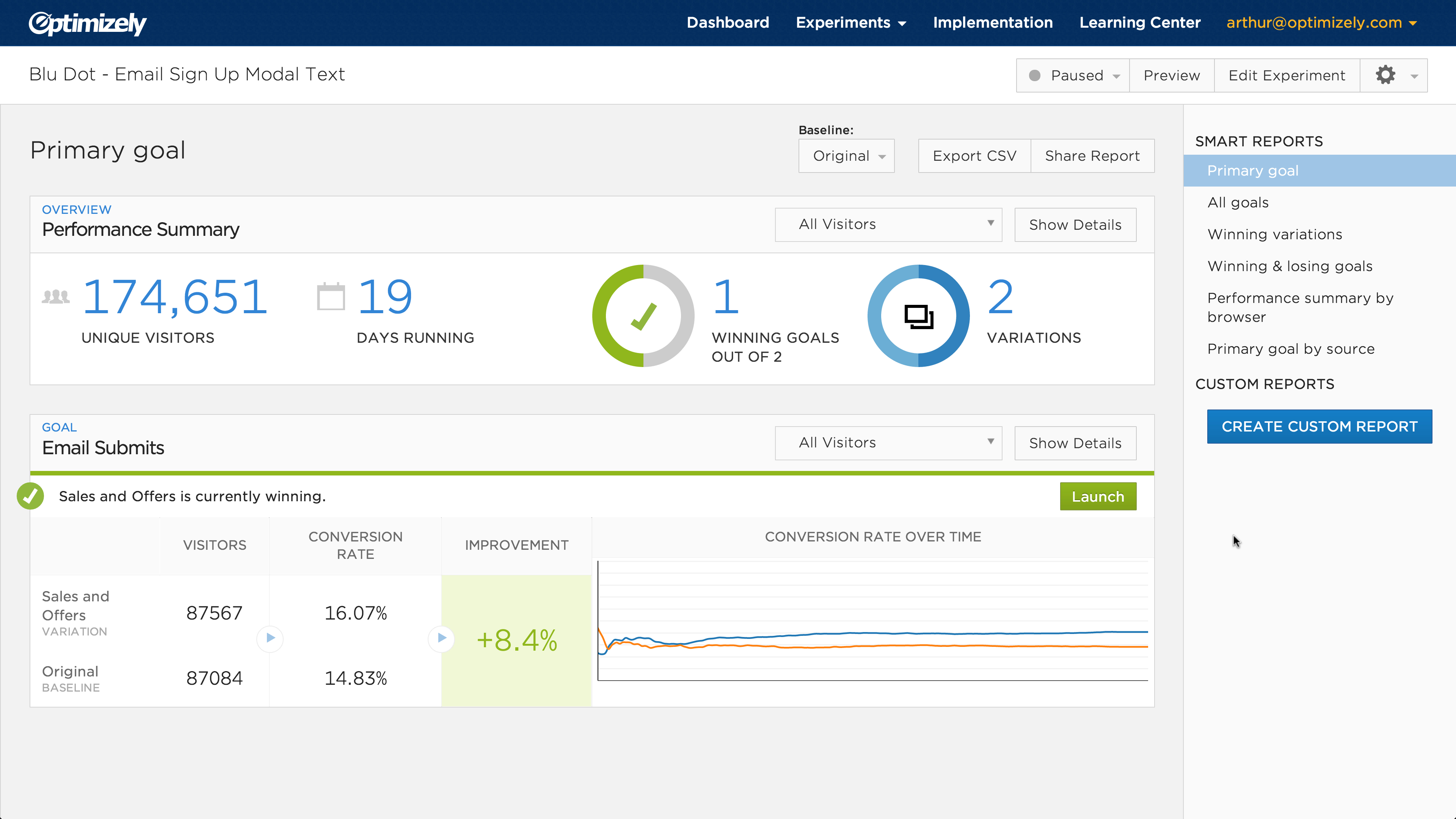
Optimizely pros:
Time to get going. Optimizely is the fourth landing page builder solution in our review, and one that takes a unique approach to building landing pages. Optimizely focuses on building experiences rather than just landing pages that convert. Many users claim Optimizely is among the easiest to set up and get going.
Feature richness. Optimizely considers itself an “experimentation platform” rather than solely a landing page builder tool. This tool allows users to focus on streamlining and improving the entire customer experience.
Optimizely also offers users tools and features to perform and run tests and experiments across websites, mobile apps, and more to allow marketing teams to understand how their website and landing pages are performing and what they can do to further “optimize” or improve them in order to drive more conversions.
Ease of use. Based on my own experience with earlier versions of Optimizely, and after talking with many of my peers who currently use the product, we believe that Optimizely is easy to use. Its highly intuitive and clean interface provides for a great user experience.
Optimizely cons:
Price. After reviewing their website, Optimizely lists out multiple plans for businesses of different sizes and needs, which can help them to determine which package might make the most sense. However, Optimizely doesn’t list out prices. This requires speaking with an Optimizely sales representative. After reading a handful of customer reviews, many users claim that Optimizely doesn’t provide good value for the cost. Additionally, Optimizely, once a more affordable solution, has targeted enterprise users with more powerful functionality and increased prices considerably. When I first used Optimizely I was paying less than $100 a month for its services, but now you won’t find a package for less than a few hundred dollars a month.
Grade: B+ (3.6 out of 5 possible points)
And the best landing page builder tool is…
All in all, after reviewing each of these tools, HubSpot appears to be the best option for both a simple landing page builder as well as a full marketing dashboard. HubSpot offers the best features for the cost.
Here is how the individual scores for our four grading criteria add up to our final grading:
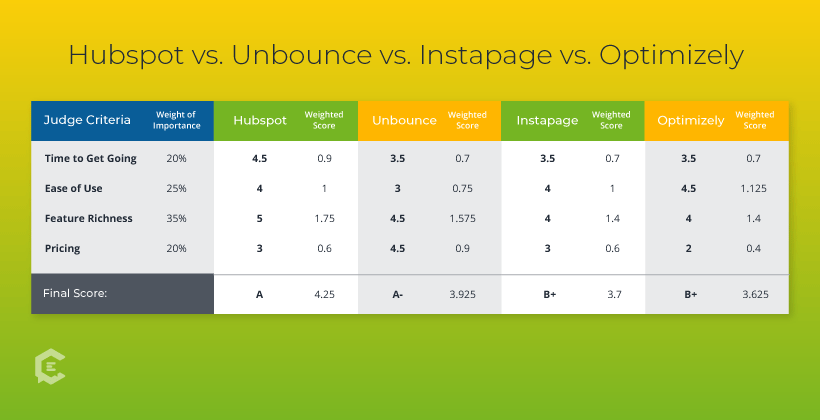
With that being said, Unbounce, Instapage and Optimizely are still great options, depending on your usage needs.







